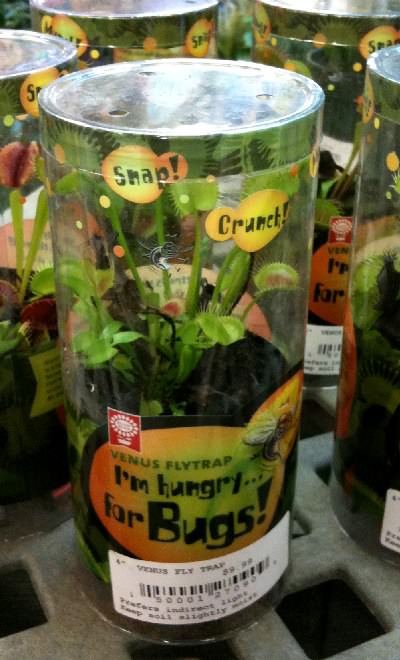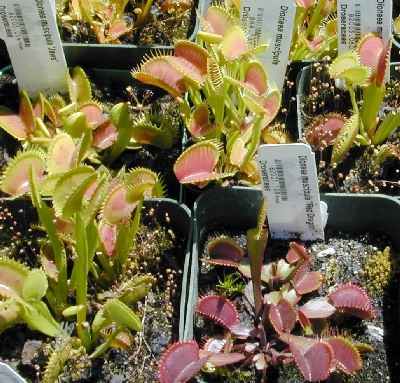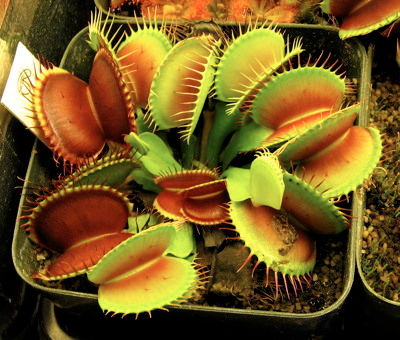So you bought your first Dionaea muscipula, commonly known as the Venus flytrap (VFT) and you would like to keep it alive for a while. It probably came in a tiny pot covered by a plastic cup "terrarium". What to do and what not to do?
- Ditch the plastic cup terrarium. The grower put it there to protect the plant during shipping, to protect the plant from neglect by the nursery staff, and to protect the plant from abuse by the customers. The grower did not put it there because it makes the plant happy. Terrariums are not needed by VFT's and can be dangerous to their health. Plants that have been in greenhouses and plastic cup terrariums may take a while to acclimate to drier air but acclimate they will.
- Keep the tiny pot. VFT's don't have much in the way of roots and it will not get root-bound in that pot. The only reason to repot the plant would be because a larger pot would provide a more stable environment for the roots or the growth point of the plant has hit the edge of the pot. I suggest a pot 8 cm (3 inches) in diameter and 10 cm (4 inches) tall with a soil of 50% peat moss and 50% coarse silica sand with a 1 cm (half inch) layer of coarse silica sand on the top. However, wait to do this until the plant has acclimated to your conditions and is growing well. If you absolutely do need to repot it, put it in a plastic bag for a few weeks after repotting.
- Sit the pot with the plant in a dish of water about 1 to 2 cm (half to 1 inch) deep. DO NOT EVER LET THE DISH DRY OUT. And don't use just any water. Bottled drinking water is death to VFT's; so is most tap water that comes from wells. Use distilled, reverse osmosis, or rain water unless your tap water is very pure. In the wild, VFT's live in an area that gets a lot of rain and the water table is just a few inches below the surface of the soil.
- Put the plant in a window that has the sun coming in, under an LED light, or outside in the sun. To do well, the plant needs at least six hours of direct sunlight every day. This is hard to do in a house. The plant will start declining immediately if it doesn't get enough light. Consider growing it under a an LED light. You don't need special "plant" lights. A desk lamp with a standard white LED spotlight works as well. The light should be on 12 to 16 hours a day.
- Do not fertilize your plant. Yes, VFT's have been known to survive being fertilized but it is best not to. In the wild they live in areas with very low soil nutrients so they are not used to dealing with fertilizer. When you get new soil for your plant, read the label carefully. You want only Sphagnum peat or peat moss without added fertilizer and horticultural or silica sand blasting sand. Do not use potting mix or play sand or builders sand for your VFT's.
- Do play with your plant. VFT's are not fragile plants so don't be afraid of hurting it. It is OK to trigger the leaves as often as you want. They should be open again the next day. At some point the traps may not close any more but that is fine. In fact you can tell the health of your plant by how quickly the traps close. If they close very quickly, your plant is doing very well. If they close slowly, either the leaf is too young or too old or your plant wants more light.
- If your plant is not catching prey on its own, you need to feed it regularly to keep it healthy and growing. Only feed a VFT live food or fake live food. VFT's are very picky about their food because they don't want to waste energy "eating" rain or dirt or debris. A trick for feeding VFT's is to use cold flies. Catch flies in a jar and then put the jar in the refrigerator for a few hours. Cold flies can't fly. Be careful about feeding worms to your plant because they can eat their way out and also may pretend to be twig and the trap will let them out. To fake live food, use Dried Blood Worms available in tropical fish stores. Soak a large pinch of dried worms in a small amount of water for a few minutes then put the guky mass in a trap using forceps. This should trigger the trap. Gently massage the closed trap so it thinks the blood worms are wiggling.
- Leaves on your plant will die and turn black. Individual leaves only last a few months. A healthy plant will be constantly putting on new leaves and the old ones will be dying back. This is what you want to happen. If the plant stops producing leaves, feed it as soon as you can. I recommend cutting off any flower stalks as soon as you see them so the plant does not waste energy on flowers. In spite of the fact the person who named the plant after Venus said it was because of the pretty white flowers, don't believe it.
- Growing your plant outside has issues. You can forget to refill the water dish. You might go on vacation. Jays will uproot newly planted plants. Raccoons and other animals can make a horrible mess digging in the pot or trying to get to the water in the dish. Squirrels and Jays will plant things in your pot. Aphids love VFT's and will cause deformed leaves. That's life on this planet.
-- John Brittnacher
July 2009
Last Update July 2019
For more information please see:
Dionaea Leaf Pullings Step-by-Step
Dried Blood Worms Step-by-Step

Trapped Venus flytrap. Release it at soon as you get it home.

Dionaea muscipula growing outside in full sun.

Dionaea muscipula 'B52' in a terrarium with the lights on 15 hours a day.
